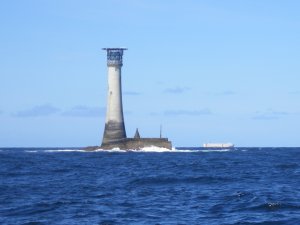
Tel: (01736) 786900
Email: enquiries@trinityhouse.co.uk
Web: www.trinityhouse.co.uk/lighthouses-and-lightvessels/wolf-rock-lighthouse
Owing its name to the unique howl heard when the wind filled the fissures of the rock, which is nine miles south-west of Land's End, or possibly too, because of the assumed shape of the rock to a wolf's head, the station came into Trinity House history with the leasing to a Mr Henry Smith, the right to mark this marine hazard in 1791. Since it is fully exposed to the Atlantic Ocean it receives a tremendous pounding in bad weather.
Originally intending to build a lighthouse, Mr Smith found the task too daunting and finally constructed a wrought iron mast eighteen feet high and four inches in diameter, complete with six stays and surmounted by a metal model of a wolf on the rock. This day-mark, since it was not a lighted beacon, was finally erected in 1795 and was less substantial than had been specified, and although it offered little resistance to the Atlantic, the sea soon carried it away.
During the years 1836 to 1840 an iron beacon was located on the rock. It was designed by James Walker, the famous lighthouse builder, in the form of a cone constructed of iron plates and filled with cement rubble, having a base fifteen feet in diameter and of equal height. The difficulties of erecting a beacon were enormous; as an instance of this it was recorded that in five years there were only 302 hours during which work could be carried out. The beacon was completed successfully at a cost of £12,000 and its sturdiness can be judged by the fact that it still remains part of the present landing.
In 1861, work commenced on a granite tower, which was designed by Sir James Douglass, which followed the generally accepted lines of Smeaton's Eddystone tower. One ingenious measure was adopted in connection with the lower courses in order to prevent the action of the waves from breaking up the cement in the exposed joints and setting up disintegration; the upper surface of each stone was given a wide rabbet and the stone above fitted into the recess so that the horizontal joint between the two was covered by the outer fillet, thereby protecting it completely. This practice was followed throughout by all the courses to a height of 39 feet and the security thus obtained is reflected by the strength of the tower today.
Work proceeded so slowly in the early stages owing to the abnormal conditions, that by the end of 1864 only 37 stones in the second course of masonry were laid. In the meantime, however, the landing stage had been practically completed and the erection of the crane enabled blocks for the tower to be transferred to the rock with the greater ease and rapidity. The tower was completed on 19th July 1869 and the light was brought into service on the 1st January 1870. Progressing from oil illuminant at its inception the station has generated electric power in 1955.
The height of the tower from foundation to gallery is 116 feet, the diameter at the base is 42 feet taping to 16 feet at the top. It is solid for 39 feet, the walls are seven feet tapering to two feet in thickness; 3,297 tons of granite were used in constructing the tower and 1,078 tons of granite in constructing the landing platform. The cost of the enterprise was £62,726.
In March 1941 the lantern was hit by aerial cannon fire, shattering the glass of the lenses. For a time afterwards the red flash was removed and it simply flashed white, every thirty seconds. The lighthouse was equipped with a radio-telephone in 1941, which greatly improved communications; it came with a petrol-driven generator for recharging its batteries. On 18th December 1944, German submarine U-1209 hit Wolf Rock and was subsequently scuttled with the loss of nine lives.
In 1973 the lighthouse achieved world wide publicity as the first rock lighthouse to have a helideck constructed on top of the lantern housing, this station was the prototype of many Trinity House lighthouses offshore.
In July 1988 the station was automated and de-manned and is now monitored from the Trinity House Operations Control Centre at Harwich in Essex.
The vessel 'Mazarine' grounded near the lighthouse on 10th July 2023, while on a voyage from Ireland to Zeebrugge, Belgium. Managing to clear the rock, 'Mazarine' was initially unable to start the engines and drifted towards Mount's Bay. At around 16:00 hours a tug provided a tow to Falmouth Bay.
Cornish Lighthouses Cornwall's Shipwrecks Land's End The Coastal Footpath